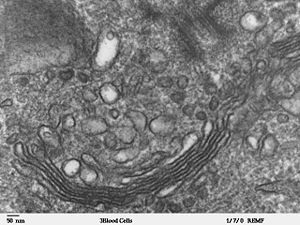Golgi apparatus: Difference between revisions
imported>Trevor Ebbens m (→Composition) |
mNo edit summary |
||
| Line 11: | Line 11: | ||
==Function== | ==Function== | ||
Through adding certain signal [[oligosaccharide]]s a protein can be tagged to be transported to a specific area of the cell. | Through adding certain signal [[oligosaccharide]]s a protein can be tagged to be transported to a specific area of the cell.[[Category:Suggestion Bot Tag]] | ||
Latest revision as of 16:00, 22 August 2024
The Golgi apparatus (also called the Golgi complex) is an important organelle in eukaryotic cells. The Golgi apparatus further modifies many proteins and lipids from the endoplasmic reticulum. Afterwards, they get transferred to different places within or outside of the cell.
History
The Golgi apparatus is named after Camillo Golgi who discovered it in 1898.
Composition
Its morphology varies considerably between different cell types. In higher eukaryotic cells the Golgi apparatus usually consists of three to ten cisternaes of around diameter which are arranged as a stack. Those cisternaes are flattened which leads to a high surface-to-volume ratio which could facilitate the activity of the enzymes inside the Golgi apparatus.
Function
Through adding certain signal oligosaccharides a protein can be tagged to be transported to a specific area of the cell.

